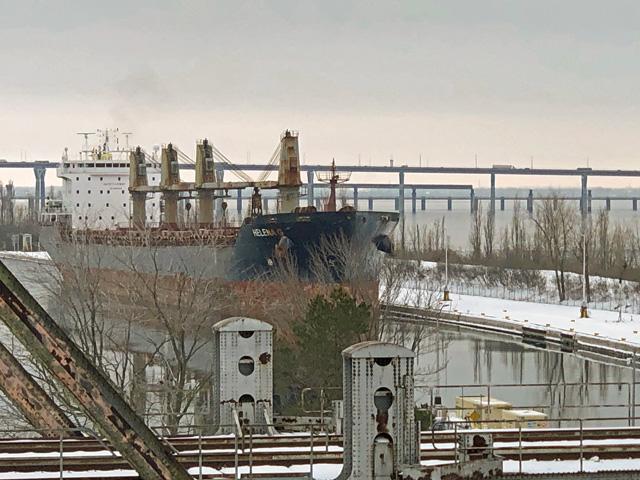Cash Market Moves
Port of Duluth-Superior, St. Lawrence Seaway Shipments Rebound in 2021
As the Great Lakes continue to hibernate, both the Port of Duluth Superior and the St. Lawrence Seaway released their 2021 shipping season summaries, showing a strong shipping season compared to 2020.
"Rebounding from pandemic-induced lows in 2020, total maritime tonnage through the Port of Duluth-Superior climbed to 32.9 million short tons in 2021. This total represented a 27% season-over-season increase and a 2.3% improvement over the five-season average," noted the Jan. 31, 2022, press release from the Duluth Seaway Prot Authority.
Iron ore, the port's leading cargo by tonnage, led the upswing. The total taconite float topped 20 million short tons for the second time in four seasons, a feat unmatched since the early 1990s. In all, 20.4 million short tons of iron ore transited Duluth-Superior during the 2021 season, a 32.6% season-over-season spike and 11.9% gain on the five-season average. Vessel arrivals in the Port of Duluth-Superior jumped more than 16% compared to 2020.
Driven primarily by Duluth-Superior's first petcoke exports since the 1990s, the coal and petcoke category posted the biggest percentage increase compared to 2020, jumping 47% to 7.9 million short tons, noted the report. Petroleum coke, or petcoke, is a product produced from all types of oil (light/heavy crudes) during the oil refining process.
Inbound cement tonnage also surged, more than doubling the 2020 total and exceeding the five-season average by 71.3%, noted the news release.
However, grains such as wheat and durum, the port's No. 1 export, suffered a steep drop to 808,498 short tons for the season. This marked an 85-year low for Duluth-Superior grain tonnage and was the second lowest seasonal grain total for the port since 1890. Severe drought in Montana, the Dakotas and northwest Minnesota, which began before planting season and lasted through harvest, was the main culprit. USDA Small Grains Report on Sep. 30, 2021, showed the levels of production and changes from 2020 for other spring wheat down 44% at 331 million bushels (mb) and durum wheat down 46% at 37.3 mb.
"We hoped for a return to normalcy in 2021 and a tonnage rebound from the pandemic-plagued 2020 season," said Deb DeLuca, executive director of the Duluth Seaway Port Authority. "We're still waiting on the return to normalcy, but the overall tonnage bounce back was pronounced, driven especially by strong demand for domestic steel. Our port continues to be a key link in North America's supply chain, and we look forward to playing an increasingly prominent role in 2022 as we hopefully build on the bulk cargo tonnage and expand our containerized cargo services."
P[L1] D[0x0] M[300x250] OOP[F] ADUNIT[] T[]
ST. LAWRENCE SEAWAY REPORTS SUCCESSFUL 2021 SEASON
The St. Lawrence Seaway Management Corporation (SLSMC) announced on Jan. 19 more than 38 million metric tons (mmt) of cargo transited the system during the 2021 navigation season which, despite another challenging year, is above last year's results.
Iron ore, steel slabs and other steel products posted strong performances, contributing to over 10.5 met of the total. This was driven by demand from both the automotive and construction industries, noted the press release.
"These results, and the fact that we traded cargo with over 50 countries, confirm the Seaway's role as an important transportation corridor connecting North America's largest industrial hubs to markets around the world, as well as in identifying export opportunities and contributing to the economic recovery," said SLSMC. "Petroleum products and other essential chemical products were up some 5% and are starting to return to more-normal levels. Such varied cargoes as stone, cement, potash and aluminum were also up."
However, the overall grain shipping season was down. Grain shipments of 10.6 mmt, were below the exceptional results in 2020 due to a smaller crop and drought conditions in both western Canada and the western U.S. and upper U.S. Midwest in 2021. Canadian grain shipments though, were still tracking at a five-year average.
"At the Seaway, we continue to demonstrate our resiliency and operational sustainability", said Terence Bowles, president and CEO of the SLSMC.
"In spite of the many challenges experienced by the transportation industry this past year, the Seaway was able to maintain its operations and its position as a reliable commercial transportation corridor, ensuring consistent and predictable service for its customers and supporting the Canadian and U.S. economies during this difficult period."
Craig H. Middlebrook, deputy administrator of the U.S. Great Lakes St. Lawrence Seaway Development Corporation (GLS) said, "Throughout another year of challenges to the transportation industry, the Seaway's performance highlighted its continued resiliency as a maritime supply chain. The Seaway handled an increase in cargo tonnage over the navigation season, and did so safely, reliably, sustainably, and in an environmentally sensitive manner. Seaway users know they can rely on the waterway to meet their domestic and international cargo needs."
The last commercial transit of the 2021 navigation season through the Montreal-Lake Ontario section occurred on Dec. 31. The Welland Canal had a later closing date, with the final vessel transiting on Jan. 7. The Seaway canals and locks traditionally reopen for shipping in mid-March, with major maintenance programs occurring during the non-navigation season.
Here is a link to a complete summary of the Seaway annual summary along with info about the entire St. Lawrence Seaway: https://greatlakes-seaway.com/…
Here is a link to the live stream of the Soo Locks, Sault Ste Marie, Michigan, currently in hibernation until spring arrives and the ships return. The locks are operated by the U.S. Army Corps of Engineers. https://streamtimelive.com/…
Here is a link to the live stream Duluth Canal Cam where you can see current conditions as the canal waits for spring to welcome the first saltie after it transits through the Soo Locks, which are the doorway that opens to Lake Superior: https://www.duluthharborcam.com/…
Mary Kennedy can be reached at mary.kennedy@dtn.com
Follow her on Twitter @MaryCKenn
(c) Copyright 2022 DTN, LLC. All rights reserved.




